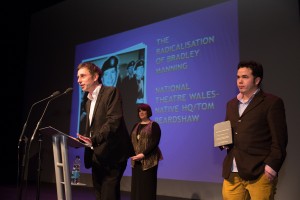
Big thanks to the theatre critics of Wales for giving us an award for the best use of digital/online content at the inaugural Theatre Critics of Wales Awards in Cardiff this weekend. We won it for our work with National Theatre Wales on The Radicalisation of Bradley Manning, by Tim Price.
We designed an online project that created a native web experience of the play by embedding CCTV cameras into the set of the show, livestreamed the play and gave the online audience a chat space to communicate with each other and external links for viewers to explore the story in more depth that changed throughout the play to reflect what you were watching.
 With Wikileaks, Anonymous and the Bradley Manning Campaign all tweeting links to the web production, nearly 10,000 people watched the play as it was beamed from Tasker Milwood school in Haverford West, Cardiff and Connah’s Quay in North Wales. On the final day of the show in North Wales, someone in the council switched off the internet for the weekend, so we were left streaming the production through a 3G phone tether!
With Wikileaks, Anonymous and the Bradley Manning Campaign all tweeting links to the web production, nearly 10,000 people watched the play as it was beamed from Tasker Milwood school in Haverford West, Cardiff and Connah’s Quay in North Wales. On the final day of the show in North Wales, someone in the council switched off the internet for the weekend, so we were left streaming the production through a 3G phone tether!
Bradley has nearly been in prison without a full trial for 1000 days. It now seems very likely that he did indeed leak the documents that he has been accused of sending to Wikileaks and with many Americans baying for blood, it’s is likely he will face a jail sentence. But having been a catalyst for the Arab Spring and brought the truth of American action in war and foreign policy thinking to global awareness, it seems like this Welsh Geek has done more in his young life to change the world than most of us ever will.
Many thanks to everyone involved in the production – Lucy, David, Jacob and Mike, to the creative team Tim, Chloe, Natasha, Mike, the cast and crew, and special thanks to John McGrath, the artist director of National Theatre Wales, for his vision and bravery in making NTW one of the most innovative digital theatre companies in the world.
Find out more about the campaign to support him through his ordeal by visiting the Bradley Manning Support Network.
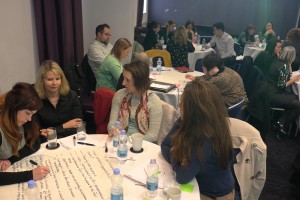


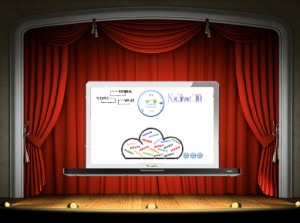
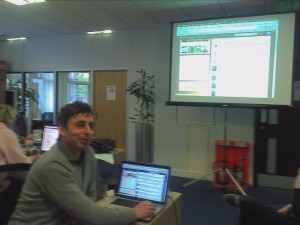
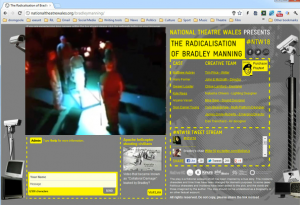

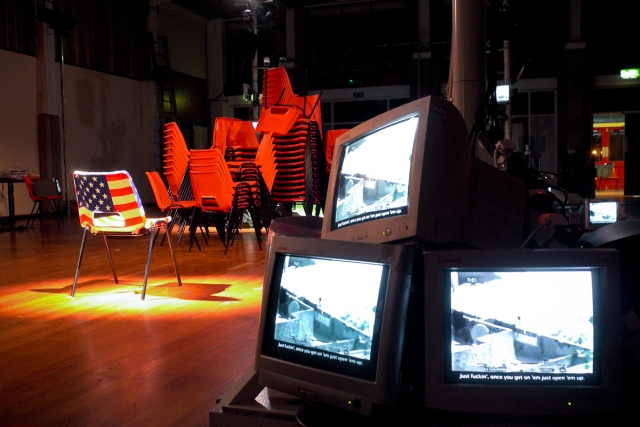
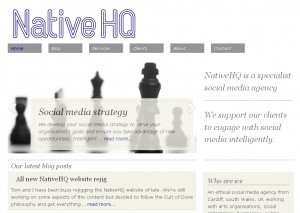
Ada Lovelace Day 2012: Dr Kelly Page
Ada Lovelace Day is an international celebration of the achievements of women in technology. You can read more on the event’s website.
This year I would like to mention someone who is very dear to us at NativeHQ and is well known among web people in Cardiff, where we live and work.
She is a highly versatile thinker who has no problem recasting the original question, category or definition on the basis of what happens along the way. That is a rare attitude. She has been known to remark, in one of her favourite phrases, that there are ‘a lot of learnings’ – a reflection of her curiosity and openness to new insights, however they might be found. She is a great asset to organisations, at least those that are willing to be inspired and learn with her.
Tom and I have benefited hugely from our conversations with Kelly, many of which have fundamentally changed the way we do things. As well as her flawless professionalism as a person she is generous, good at meaningful encouragement and big on laughs.
Although she maintains links to Wales, Kelly and her gigantic brain departed for a life in the USA earlier this year. And although it is a great pity for us as we don’t see her as often anymore, we know she is thriving on the new challenges and we look forward to future discussions – on whichever shore they may be.